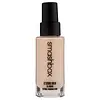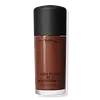Smashbox Studio Skin 24 Hour Hydra Foundation Versus Mac Cosmetics Studio Fix Fluid Foundation With SPF 15
What's inside
What's inside
 Key Ingredients
Key Ingredients

 Benefits
Benefits

 Concerns
Concerns

 Ingredients Side-by-side
Ingredients Side-by-side

Water
Skin ConditioningCyclopentasiloxane
EmollientTrimethylsiloxysilicate
EmollientTitanium Dioxide
Cosmetic ColorantButylene Glycol
HumectantTrimethyl Pentaphenyl Trisiloxane
EmollientSilica
AbrasivePhenyl Trimethicone
Skin ConditioningMagnesium Sulfate
Polyglyceryl-3 Diisostearate
EmulsifyingTribehenin
EmollientPEG-10 Dimethicone
Skin ConditioningBis-PEG/PPG-14/14 Dimethicone
EmollientTocopheryl Acetate
AntioxidantSodium Hyaluronate
HumectantGlycerin
HumectantEthylhexylglycerin
Skin ConditioningPolyglyceryl-4 Isostearate
EmulsifyingCetyl PEG/PPG-10/1 Dimethicone
EmulsifyingMethicone
EmollientTetramethyl Hexaphenyl Tetrasiloxane
Skin ConditioningPhenyl Methicone
EmollientDimethicone
EmollientLaureth-7
EmulsifyingPolymethylsilsesquioxane
Hexyl Laurate
EmollientDisteardimonium Hectorite
StabilisingCellulose Gum
Emulsion StabilisingPropylene Carbonate
SolventAlumina
AbrasiveXanthan Gum
EmulsifyingDimethicone Silylate
Sorbic Acid
PreservativePhenoxyethanol
PreservativeChlorphenesin
AntimicrobialIron Oxides
CI 77891
Cosmetic ColorantWater, Cyclopentasiloxane, Trimethylsiloxysilicate, Titanium Dioxide, Butylene Glycol, Trimethyl Pentaphenyl Trisiloxane, Silica, Phenyl Trimethicone, Magnesium Sulfate, Polyglyceryl-3 Diisostearate, Tribehenin, PEG-10 Dimethicone, Bis-PEG/PPG-14/14 Dimethicone, Tocopheryl Acetate, Sodium Hyaluronate, Glycerin, Ethylhexylglycerin, Polyglyceryl-4 Isostearate, Cetyl PEG/PPG-10/1 Dimethicone, Methicone, Tetramethyl Hexaphenyl Tetrasiloxane, Phenyl Methicone, Dimethicone, Laureth-7, Polymethylsilsesquioxane, Hexyl Laurate, Disteardimonium Hectorite, Cellulose Gum, Propylene Carbonate, Alumina, Xanthan Gum, Dimethicone Silylate, Sorbic Acid, Phenoxyethanol, Chlorphenesin, Iron Oxides, CI 77891
Ethylhexyl Methoxycinnamate 2.5%
UV AbsorberTitanium Dioxide 1%
Cosmetic ColorantWater
Skin ConditioningCyclopentasiloxane
EmollientPEG-10 Dimethicone
Skin ConditioningButylene Glycol
HumectantTrimethylsiloxysilicate
EmollientDimethicone
EmollientMagnesium Sulfate
Laminaria Saccharina Extract
Skin ProtectingAlgae Extract
EmollientTocopheryl Acetate
AntioxidantSodium Hyaluronate
HumectantTocopherol
AntioxidantLecithin
EmollientHydrogenated Lecithin
EmulsifyingXanthan Gum
EmulsifyingSorbitan Sesquioleate
EmulsifyingMethoxy Amodimethicone/Silsesquioxane Copolymer
Skin ConditioningLaureth-7
EmulsifyingDipropylene Glycol
HumectantDimethicone/PEG-10/15 Crosspolymer
Dimethicone/PEG-10 Crosspolymer
EmollientPEG/PPG-18/18 Dimethicone
EmulsifyingDisteardimonium Hectorite
StabilisingSilica
AbrasiveDimethicone Crosspolymer
Emulsion StabilisingTriethoxycaprylylsilane
Propylene Carbonate
SolventPentaerythrityl Tetra-Di-T-Butyl Hydroxyhydrocinnamate
AntioxidantSorbic Acid
PreservativeChloroxylenol
AntimicrobialPhenoxyethanol
PreservativeCI 77891
Cosmetic ColorantIron Oxides
Chromium Oxide Greens
Ethylhexyl Methoxycinnamate 2.5%, Titanium Dioxide 1%, Water, Cyclopentasiloxane, PEG-10 Dimethicone, Butylene Glycol, Trimethylsiloxysilicate, Dimethicone, Magnesium Sulfate, Laminaria Saccharina Extract, Algae Extract, Tocopheryl Acetate, Sodium Hyaluronate, Tocopherol, Lecithin, Hydrogenated Lecithin, Xanthan Gum, Sorbitan Sesquioleate, Methoxy Amodimethicone/Silsesquioxane Copolymer, Laureth-7, Dipropylene Glycol, Dimethicone/PEG-10/15 Crosspolymer, Dimethicone/PEG-10 Crosspolymer, PEG/PPG-18/18 Dimethicone, Disteardimonium Hectorite, Silica, Dimethicone Crosspolymer, Triethoxycaprylylsilane, Propylene Carbonate, Pentaerythrityl Tetra-Di-T-Butyl Hydroxyhydrocinnamate, Sorbic Acid, Chloroxylenol, Phenoxyethanol, CI 77891, Iron Oxides, Chromium Oxide Greens
 Reviews
Reviews

Ingredients Explained
These ingredients are found in both products.
Ingredients higher up in an ingredient list are typically present in a larger amount.
Butylene Glycol (or BG) is used within cosmetic products for a few different reasons:
Overall, Butylene Glycol is a safe and well-rounded ingredient that works well with other ingredients.
Though this ingredient works well with most skin types, some people with sensitive skin may experience a reaction such as allergic rashes, closed comedones, or itchiness.
Learn more about Butylene GlycolCi 77891 is a white pigment from Titanium dioxide. It is naturally found in minerals such as rutile and ilmenite.
It's main function is to add a white color to cosmetics. It can also be mixed with other colors to create different shades.
Ci 77891 is commonly found in sunscreens due to its ability to block UV rays.
Learn more about CI 77891Cyclopentasiloxane, or D5, is a silicone used to improve texture of products and trap moisture.
D5 is considered lightweight and volatile. Volatile means it evaporates quickly after application. Once evaporated, D5 leaves a thin barrier that helps keep skin hydrated.
It is also an emollient. Emollients help soften the skin and prevent water loss. Silicones create a silky texture in products. D5 helps other ingredients become more spreadable.
Studies show D5 is safe to use in skincare products. We recommend speaking with a skincare professional if you have concerns.
Learn more about CyclopentasiloxaneDimethicone is a type of synthetic silicone created from natural materials such as quartz.
What it does:
Dimethicone comes in different viscosities:
Depending on the viscosity, dimethicone has different properties.
Ingredients lists don't always show which type is used, so we recommend reaching out to the brand if you have questions about the viscosity.
This ingredient is unlikely to cause irritation because it does not get absorbed into skin. However, people with silicone allergies should be careful about using this ingredient.
Note: Dimethicone may contribute to pilling. This is because it is not oil or water soluble, so pilling may occur when layered with products. When mixed with heavy oils in a formula, the outcome is also quite greasy.
Learn more about DimethiconeDisteardimonium Hectorite comes from the clay mineral named hectorite. It is used to add thickness to a product.
It can also help stabilize a product by helping to disperse other ingredients.
Hectorite is a rare, white clay mineral.
Learn more about Disteardimonium HectoriteLaureth-7 is created by the ethoxylation of lauryl alcohol using ethylene oxide. Lauryl alcohol is a fatty alcohol with hydrating properties.
This ingredient is an emulsifier and cleansing ingredient. As an emulsifier, it is used to prevent ingredients from separating. It also helps cleanse the skin by gathering dirt, oil, and pollutants to be rinsed away.
Magnesium Sulfate is a salt. More specifically, it is an epsom salt, or the bath salt used to help relieve muscle aches.
Despite having ‘sulfate’ in the name, it isn’t a surfactant or cleansing agent like sodium lauryl sulfate. Unlike those sulfates, magnesium sulfate doesn’t have the same cleansing or foaming properties (it's simply a type of salt).
In cosmetics, Magnesium Sulfate is used to thicken a product or help dilute other solids. It is a non-reactive and non-irritating ingredient.
One study shows magnesium deficiency may lead to inflammation of the skin. Applying magnesium topically may help reduce inflammation.
You can find this ingredient in sea water or mineral deposits.
Learn more about Magnesium SulfatePeg-10 Dimethicone is silicone with conditioner and emulsifier properties. It mostly acts as an emollient in skincare and and humectant in haircare.
According to the manufacturer, acidic formulations decrease the stability of this ingredient. It works best in neutral or near neutral formulations.
Phenoxyethanol is a preservative that has germicide, antimicrobial, and aromatic properties. Studies show that phenoxyethanol can prevent microbial growth. By itself, it has a scent that is similar to that of a rose.
It's often used in formulations along with Caprylyl Glycol to preserve the shelf life of products.
This ingredient is a solvent. It helps dissolve active ingredients and alter the texture of products.
Propylene Carbonate is commonly used in makeup and with clay, such as montmorillonite or bentonite.
Studies show this ingredient to be safe for cosmetics. When it is undiluted, it can cause skin irritation. (It is always diluted in skincare and makeup). This ingredient is water-soluble.
Propylene Carbonate is created from propylene glycol and carbonic acid.
Learn more about Propylene CarbonateSilica, also known as silicon dioxide, is a naturally occurring mineral. It is used as a fine, spherical, and porous powder in cosmetics.
Though it has exfoliant properties, the function of silica varies depending on the product.
The unique structure of silica enhances the spreadability and adds smoothness, making it a great texture enhancer.
It is also used as an active carrier, emulsifier, and mattifier due to its ability to absorb excess oil.
In some products, tiny microneedles called spicules are made from silica or hydrolyzed sponge. When you rub them in, they lightly polish away dead skin layers and enhance the penetration of active ingredients.
Learn more about SilicaSodium Hyaluronate is hyaluronic acid's salt form. It is commonly derived from the sodium salt of hyaluronic acid.
Like hyaluronic acid, it is great at holding water and acts as a humectant. This makes it a great skin hydrating ingredient.
Sodium Hyaluronate is naturally occurring in our bodies and is mostly found in eye fluid and joints.
These are some other common types of Hyaluronic Acid:
Learn more about Sodium HyaluronateSorbic Acid is a preservative. It is the most commonly used food preservative in the world.
Sorbic Acid is a natural antibiotic and highly effective at preventing the growth of fungus. It is less effective against bacteria.
Potassium Sorbate, another commonly-used preservative, is the potassium salt of Sorbic Acid.
Sorbic Acid may worsen eczema. We recommend speaking with a professional if you have any concerns.
Potassium sorbate and sorbic acid can be found in baked goods, cheeses, dried meats, dried fruit, ice cream, pickles, wine, yogurt, and more.
Learn more about Sorbic AcidTitanium dioxide is a mineral UV filter widely used in sunscreens and cosmetics.
It is one of only two UV filters officially classified as “mineral” by regulatory agencies, the other being zinc oxide.
Titanium dioxide provides broad-spectrum protection mostly in the UVB and UVAII range, with some protection in the UVAI range.
While its UVA protection isn’t as strong as zinc oxide’s, the difference is minor.
A common myth is that mineral UV filters reflect UV light. However, modern research shows titanium dioxide absorbs UV radiation like chemical filters (~95% absorption & 5% reflection).
Thanks to its non-irritating nature, titanium dioxide is suitable for sensitive, acne-prone, or redness-prone skin. It is unlikely to cause "eye sting" like other sunscreen ingredients.
A major drawback of this ingredient is its white cast and thick texture. This is why mineral sunscreens often leave a white cast and are less cosmetically elegant than chemical/hybrid sunscreens.
To improve white cast and spreadability, micronized or nano-sized titanium dioxide is often used.
There are ongoing concerns surrounding nano-titanium oxide's impact on marine ecosystems.
There is no conclusive evidence that any form of titanium oxide (or any other sunscreen ingredients) will cause harm to marine ecosystems or coral reefs. The science is still developing but many consumers are keeping a close eye on this issue.
Please note, many destinations have reef-safety sunscreen rules. For instance, the U.S. Virgin Islands advises all visitors to use non-nano mineral sunscreens.
Nano mineral sunscreens once raised safety concerns about absorption into skin.
Extensive research has shown that they do not penetrate healthy or damaged skin; they remain safely on the surface and the top layer of dead skin (stratum corneum).
You'll likely find titanium dioxide bundled with alumina, silica, or dimethicone. These ingredients help make titanium dioxide highly photostable; this prevents it from interacting with other formula components under UV light.
Learn more about Titanium DioxideTocopheryl Acetate is AKA Vitamin E. It is an antioxidant and protects your skin from free radicals. Free radicals damage the skin by breaking down collagen.
One study found using Tocopheryl Acetate with Vitamin C decreased the number of sunburned cells.
Tocopheryl Acetate is commonly found in both skincare and dietary supplements.
Learn more about Tocopheryl AcetateThis silicone is an emollient. Emollients create a thin film on the skin to prevent moisture from escaping.
It is not soluble in water and helps increase water-resistance in products.
According to a manufacturer, it can blend seamlessly with silicone oils, such as Cyclopentasiloxane.
Learn more about TrimethylsiloxysilicateWater. It's the most common cosmetic ingredient of all. You'll usually see it at the top of ingredient lists, meaning that it makes up the largest part of the product.
So why is it so popular? Water most often acts as a solvent - this means that it helps dissolve other ingredients into the formulation.
You'll also recognize water as that liquid we all need to stay alive. If you see this, drink a glass of water. Stay hydrated!
Learn more about WaterXanthan gum is used as a stabilizer and thickener within cosmetic products. It helps give products a sticky, thick feeling - preventing them from being too runny.
On the technical side of things, xanthan gum is a polysaccharide - a combination consisting of multiple sugar molecules bonded together.
Xanthan gum is a pretty common and great ingredient. It is a natural, non-toxic, non-irritating ingredient that is also commonly used in food products.
Learn more about Xanthan GumThis ingredient is a combination of red, black, and yellow iron oxide pigments. This combination of colors is usually found in foundation, because it results in a "skin" color.